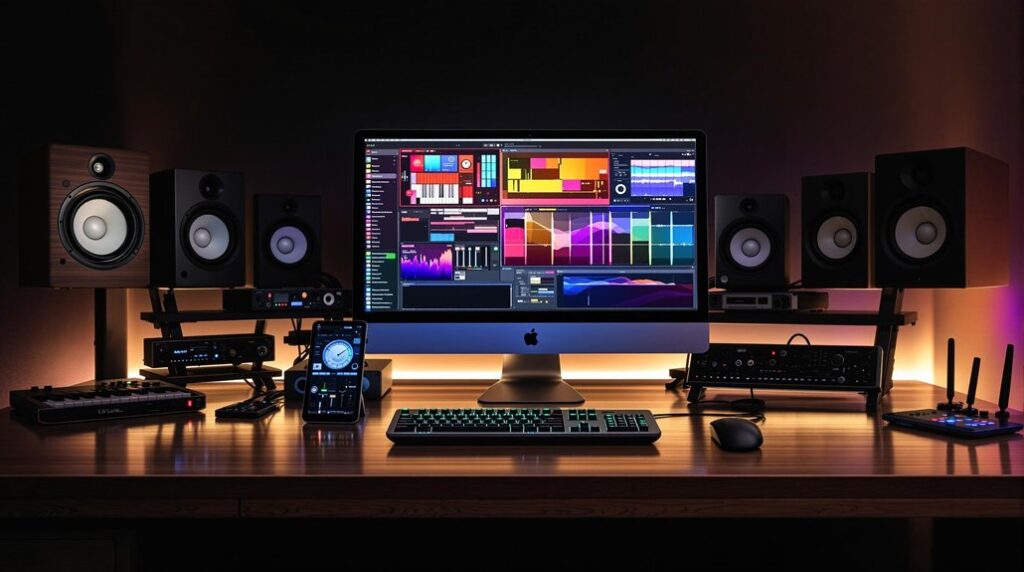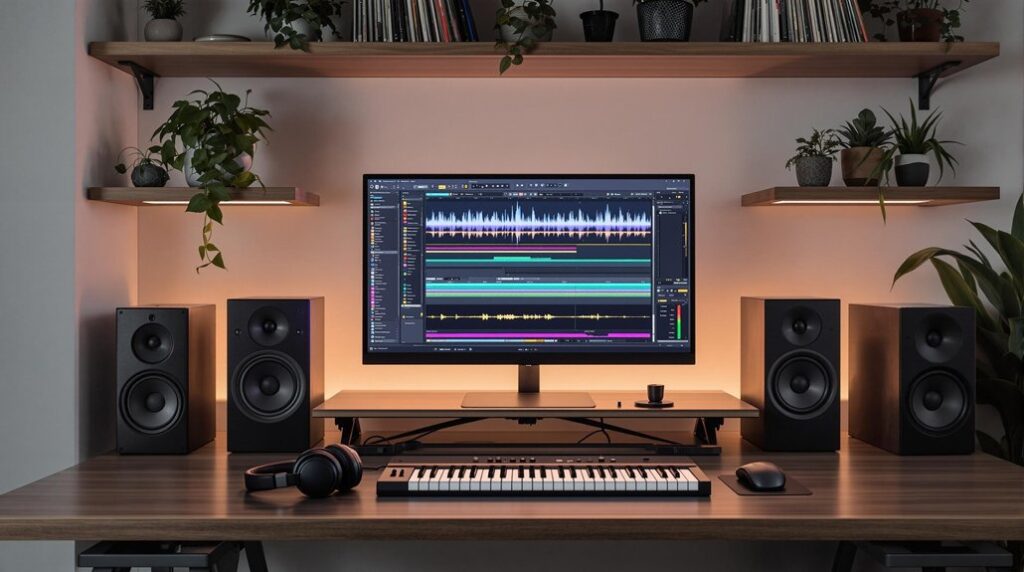To resample in Ableton, start by creating a new audio track using Command T (Mac) or Control T (Windows). Set this track’s audio input to “resampling” to capture your mixed audio output. Next, arm the track for recording by clicking the record button and guarantee all desired sounds are audible—use the solo function if needed. Finally, click record to start capturing your audio in real time. After you’ve recorded, you can further edit and manipulate the resampled audio to enhance your mix. There’s so much more to explore, so keep going to reveal additional techniques!
Key Takeaways
- Create a new audio track and set its input to “resampling” to capture mixed audio output.
- Arm the track for recording by clicking the record button to prepare for capture.
- Use the solo function to isolate specific audio channels if necessary for precise resampling.
- Start the recording to capture audio in real-time, ensuring all desired sources are audible.
- Edit the resampled audio afterward for further manipulation and enhancement of your mix.
Understanding Resampling
Resampling is a powerful technique in audio production that lets you take a section of an audio track and export it as a new file. This process gives you a little bit of freedom to manipulate audio as a distinct element, whether you’re creating unique clips or enhancing existing tracks.
You can use various resampling methods, each tailored for different editing tasks, making it versatile for your needs. It captures all audible sounds in real-time, allowing you to record entire tracks or selected elements with ease.
Plus, you can simulate effects like vinyl spin down, adding depth to your audio. Overall, understanding resampling opens up a world of creative possibilities in your productions. Additionally, utilizing tools for vocal isolation enhances the effectiveness of your resampling process by allowing you to focus on distinct audio elements.
Setting Up Resampling
Setting up resampling in Ableton is straightforward and can enhance your workflow considerably.
First, you’re going to give yourself a new audio track by pressing Command T on Mac or Control T on Windows. Next, change the audio input of this track to “resampling” to capture your mixed audio output.
Don’t forget to arm the track for recording by clicking the record enable button—it’s essential for capturing audio during playback. To keep your project organized, name the resampling track appropriately so you can easily identify it later.
Finally, verify all desired audio sources are audible; you can solo channels using Command (Mac) or Control (Windows) to solo multiple tracks at once. Additionally, ensure you have sufficient disk space for installation to avoid any interruptions during the resampling process.
Recording Audio With Resampling
When you’re ready to capture your mix, recording audio with resampling in Ableton is an effective way to guarantee you get the sound just right.
Start by creating a new audio track and set its input to “resampling.” This allows you to capture all audible sounds in real-time. If you want to isolate specific audio, use the solo function on the desired channels by pressing Command (Mac) or Control (Windows).
Resampling lets you record an entire track or selected elements, providing flexibility for your audio manipulation needs. Additionally, fine-tuning sound after resampling can enhance your overall mix quality.
Once you’ve recorded, the resampled audio is ready to be edited, chopped, and further manipulated, ensuring all effects and dynamics are preserved in your new audio file.
Frequently Asked Questions
How to Do Resampling in Ableton?
To resample in Ableton, you’ll harness creative techniques to capture audio. Set up a new track, choose “resampling” as input, arm the track, and record your desired sounds for further manipulation and experimentation.
Does Resampling Reduce Quality?
Yes, resampling can reduce quality if you’re not careful. To guarantee quality preservation, use high-quality algorithms, appropriate filtering, and dithering techniques. These methods help minimize artifacts and maintain audio fidelity throughout the process.
How to Resample Midi to Audio in Ableton?
To resample MIDI to audio in Ableton, create an audio track, set it to resampling, arm it for recording, then play your MIDI track and hit record. This captures your performance as audio, enhancing your MIDI techniques.
How Do I Change Sample Speed in Ableton?
To change sample speed in Ableton, use sample manipulation techniques. Adjust the clip’s warp markers, select an appropriate warp mode, or modify the global tempo for broader changes. Experiment with transposition and stretch settings for precise control.
Conclusion
Now that you’ve got a grasp on resampling in Ableton, you can start experimenting with your own audio creations. By understanding the process, setting up your session correctly, and recording with confidence, you’ll reveal new creative possibilities. Whether you’re layering sounds or creating unique samples, resampling adds depth and variety to your music. So, immerse yourself, have fun, and let your creativity flow—your next masterpiece is just a resample away!




